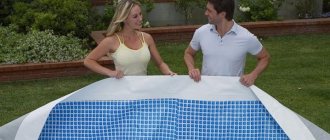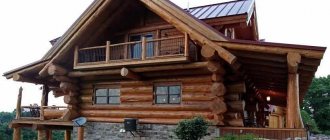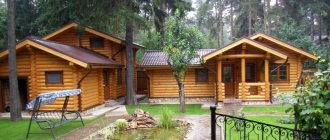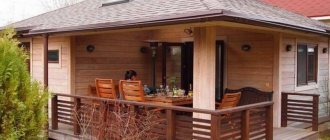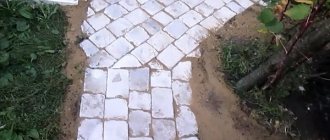It’s great when you have the opportunity to swim right on your backyard, but what about when the cold weather sets in? We suggest you figure out how to preserve a pool for the winter: instructions, videos, useful tips - all this and much more will be discussed in detail in the review.
Let us immediately note that it is quite acceptable (and some experts even recommend) not to perform any such work at all if the tank is always in a usable condition. But it is clear that certain costs are associated with this, for example, for stable maintenance of water temperature at a level of at least +5 0C. You will also have to spend money on a coating that reduces heat loss from the surface of the liquid. We are no longer talking about the fact that heating equipment needs to be monitored or at least periodically checked, but this is not always convenient and generally realistic, especially for those families who move to city apartments during the cold season.
Why close the pool for the winter?
As you know from a school physics course, water in the cold not only freezes, but also expands, which means it presses on the bottom and walls of the tank. If the latter are made of a sufficiently pliable material, for example, from some environmentally friendly polymer, cracks will most likely form in them as a result of such exposure. They will require expensive repairs to eliminate damage or even a complete replacement of the bowl, otherwise swimming will simply become impossible, because the liquid level will constantly drop.
Also keep in mind that low temperatures and precipitation are quite capable of damaging the equipment of the pumping group, skimmers, filters, heating systems, and all this is definitely relatively expensive equipment that is best removed and stored in a covered and heated garage (or utility room) until the onset of the swimming season.
At the same time, the answer to the question of whether to drain the water from the pool for the winter is far from being as clear as it might seem at first glance, because there are two options.
Sad time - the beginning of conservation
ADVICE! An autumn temperature drop below +10 ºС and the first frosts can become a signal for the start of conservation. However, there is also no need to rush, since if the autumn turns out to be warm, then premature conservation will promote the growth of algae, which even preservatives cannot prevent.
The swimming season has ended, and for every owner of a local swimming pool, the problem arises of how to protect his concrete friend from temperature changes, snowfalls and simply from unnecessary debris. To do this, it is advisable to build a roof over the pool. Decide which roof option is most suitable for you:
- Mobile, portable.
- Sliding option.
- Stationary.
The last type is divided into subspecies:
- Canopy.
- Pavilion – low, high, medium.
- Dome or cover. Can be retractable or hinged.
- Visor.
The roof can be made as in the economical version: a cover made of fiberboard, chipboard. So and the more expensive one - a sliding dome made of polypropylene. The choice of roofs is huge in stores - from a simple sliding roof to a complex pavilion. You have the right to choose your option depending on your budget and the area occupied by your home pond.
Any roof will save the pool from excess pollution and precipitation. Which will negatively affect the surface of the structure.
Types of conservation
There are 2 of them:
- Dry - with complete removal of liquid from the bowl, usually relevant for those tanks that are used indoors; in private ownership it is used less frequently.
- “Wet” – some of the H2O still remains to prevent cracks and damage to the bowl; this type is designed for external rather than internal objects and allows you to save on electricity, heating, and maintenance of the facility, which is why it is used more often.
These schemes have one goal - to prevent cracks, destruction and costly repairs. We will describe both, because each of them is good and useful in its own way, and you ultimately decide whether you need to drain the water, whether you can leave the pool with it for the winter. But since the second option is more popular, we will start with it.
When can reactivation begin?
If you carry out all the procedures for preserving a stationary pool correctly, you can ensure a successful winter for this structure. With the arrival of warm days, the ice in the pool is allowed to melt naturally. It is strictly forbidden to crush ice, as this is likely to damage the bowl of the structure. After the pool is re-opened and the water is purified, the reservoir begins to operate in accordance with its purpose.
- Author: marika
Rate this article:
- 5
- 4
- 3
- 2
- 1
(2 votes, average: 5 out of 5)
Share with your friends!
Sequence of actions for “wet” conservation
Ideally, you should familiarize yourself with it before building a bathing structure - in order to select associated equipment and provide for the transition from the summer heat to the cold season.
Therefore, we tried to describe the algorithm in as much detail as possible, paying attention even to seemingly obvious points - so that you have a clear picture of what steps to take - there are only 10 of them, and each one will not take up too much time.
Adhere to the following scheme, implement all the specified measures without errors or deviations, and you will be able to resolve the issue quickly enough, without problems and without involving third-party specialists.
Draining
To do this, it is necessary to carry out drainage even at the stage of construction of the hydraulic facility. If it is not provided, and the bowl has already been actively used and you need to deal with frost somehow, just buy an additional pump, only powerful enough to quickly pump out the liquid.
Cleaning metal parts
Give the following elements a good brush with a stiff brush:
- handrails;
- ladder;
- gratings;
- backlight
MBFT-75 Membrane for 75GPD
SF-mix Clack up to 0.8 m3/h
SF-mix Runxin up to 0.8 m3/h
After this, apply disinfectant solutions to all treated surfaces to protect them from fungi and bacteria during the entire downtime. The same must be done with technological equipment, regardless of what material the acrylic, polypropylene or concrete bowl of the tank in which it is installed and operated is made of.
This is a mandatory and very important stage in preparing the pool for winter at the dacha, and it should be carried out strictly using personal protective equipment - wearing gloves, boots, overalls and a respirator. Why? Because you will have to use rather aggressive household chemicals that should not get on your skin, mouth or eyes. Be sure to take care of your own safety.
Cleaning the walls and bottom
A similar operation must be performed with the surfaces of the hydraulic structure itself. You can use the same tools at this step, that is, a stiff brush. If your budget allows, we recommend buying a special vacuum cleaner to go with it - it will immediately remove a significant part of the raised dirt from the surfaces, significantly speeding up the work.
Dismantling lighting
When deciding how to leave the pool with water for the winter, remember that during this period no installed objects should remain in the bowl, including those responsible for its beauty. Therefore, be sure to remove these elements in the following order:
- carefully remove the protective glass;
- remove all spotlights from their niches;
- insulate the wiring well;
- Wrap each removed device in cloth and store in a dry and constantly heated room.
With the onset of the warm season, carry out the installation by repeating all of the above steps in reverse order.
Working with a pumping group
This equipment should also be taken care of by choosing a suitable operating mode for the cold period, or, more precisely, waiting, otherwise under the influence of low temperatures it may fail (rubber gaskets, hoses will leak, or some other similar problem will arise), and then it will need repairs or replacement of components, but why do you need to spend extra expenses. To prevent damage:
- turn on the “backwash” option and pass cleaning solutions through the pump filters;
- then switch to compaction mode and make sure there are no leaks;
- then return to normal operation.
Disinfection
A mandatory stage of winter conservation of the pool, because for the entire period of inactivity - and this is several weeks or even months, depending on the climate - it is necessary to prevent the growth of algae and bacteria in the water. If this is not done, in the spring you risk finding the bottom and walls overgrown with greenery. And then all these surfaces will have to be cleaned with brushes for a long time and tediously, and then also checked for the absence of pathogenic microflora, which takes time, effort and money.
Therefore, it is easier and more reliable to add special agents to the liquid and let it circulate in the filtration system for 2-3 hours. During this time, it will run several times, become saturated with useful particles to the required concentration, and all pipes will be thoroughly washed.
Salt protection
When deciding how to close the reservoir for the winter and what to do with the pool in general, remember that during the frost season the preserved water will not move. This means that additives must be added or poured into it to prevent the formation of compounds that can precipitate and generally contaminate the hydraulic structure. Spend money on these products, and you will not regret it, because they will dissolve without a trace, will not produce impurities and will not in any way affect the comfort of bathing in the future, but will not allow plaque and other organic matter to appear on the walls and bottom.
Compensator installation
It is needed to reduce the pressure of expanding H2O on the bowl and thus prevent the appearance of cracks. It will also protect the tiles and cladding, which are usually even more fragile than the frame structure of the tank, from damage.
SF-mix manual up to 0.8 m3/h
AMETHYST - 02 M up to 2 cubic meters/day.
Aeration unit AS-1054 VO-90
In practice, when deciding how to prepare a pool for winter in a country house or garden, you will definitely not have any problems choosing such protection. Because its role can be effectively performed by a variety of objects and materials, including such common ones as:
- foam sheets;
- empty plastic bottles and tanks of various capacities;
- plastic containers and canisters of suitable volume;
- used tires and tires.
In general, anything that is clean enough from an environmental point of view will not react chemically with H2O and will float. Yes, you understood correctly, such homemade compensators must be evenly distributed over the surface of the liquid, equipped with weights so that they are not blown away from their places. Naturally, the waterline will rise somewhat, which means you will have to drain several liters.
Removing the hydraulic system
When choosing how to preserve a pool in winter without draining the water, know that the technological equipment will have to be dismantled during any “wet” preservation. This is not a problem to do - just follow this algorithm:
- remove filters, counterflow, heaters one by one;
- drain or pump out the H2O remaining in the system;
- place plugs on the free ends of the pipes;
- Place moisture-resistant (impermeable) plastic bags over the valves and secure them with twine.
Tank cover
This is the final and perhaps the most important stage: by carrying it out correctly, you will prevent the influence of ultraviolet radiation on the liquid (which means the proliferation of bacteria and the growth of algae), as well as contamination of the bowl due to the ingress of foreign objects into it.
To achieve the result, you simply need to tighten the hydraulic structure from above with a suitable material, that is, sufficiently durable, strong, and resistant to UV radiation.
And now that we have already decided why to do this, let’s see what and how to cover it - we leave the pool for the winter under:
- dense polymer film;
- canvas awning;
- polycarbonate sheets;
- wooden shield.
A specific option must be purchased based on the budget, the lowest temperature that will be observed during the cold season, as well as the expected level and intensity of impacts. Thus, correctly chosen protection resists frost and humidity (normal for the region and time of year), withstands the weight of snow, and does not deform due to frequent rains or other precipitation. It also greatly simplifies maintenance of the hydraulic reservoir during downtime, reducing it to a minimum.
Just follow this step-by-step diagram and you will complete the job flawlessly.
Procedure for preparing for the winter period
Any outdoor pool, regardless of its design features, needs to be preserved for the winter. This is especially true for containers installed outdoors. Such pools are not protected from environmental influences and may suffer from adverse weather conditions. Before mothballing the pool for the winter, it is necessary to take into account several design features and other details regarding the installation location and operational characteristics.
Winter preservation consists of several stages:
- removing water and washing the main bowl;
- flushing the filtration system;
- disinfection of the main bowl and filters using aggressive detergents;
- dismantling the pumping station (pumps) and filters.
The preparatory steps depend on the type of pool. It can be stationary or framed. Containers installed in a heated room or in areas with a warm climate do not require preservation. When performing preparations, be sure to take into account the design features, the type of material of the walls and coating of the bowl, as well as the depth of the main elements.
Features and methods of conservation of a stationary pool
When preparing for conservation, pay attention to the following points:
- Prefabricated or inflatable pool. Such structures are dried, if necessary treated with a disinfectant and stored folded. The storage room must be ventilated to prevent the formation of mold on structural elements.
- Shallow pool. Conditions for preparation and storage depend on the design of the container - a shallow “pool-pond” with a composite or polypropylene bowl in warm climates does not need to be filled with water, since the materials of the bowl are not subject to extrusion loads when the soil freezes slightly.
- A stationary pool on the foundation of a building or on the roof. Stationary swimming pools, integrated into the design plan of the building and erected simultaneously with the design structure, are preserved dry. To protect against the ingress of debris or precipitation, the container is covered with film, light shields or the coating provided for in the project.
All open containers for the winter period must be covered with awnings or any frost-resistant materials that can withstand snow loads.
Preservation of a composite (plastic or concrete) pool for the winter
This is a structure whose bowl is made of several layers of material and therefore boasts strength. And the technology of its shelter, in principle, does not differ from that described above, it just has some nuances.
When carrying out this procedure, the following rules must be observed:
- take all measures strictly before the onset of the first frost;
- be sure to leave a certain volume of liquid;
- install the maximum possible number of compensators;
- pay increased attention to the quality of filtration.
A few details: it is extremely important to carry out chlorination - at least 2-3 hours, so that all H2O receives a sufficient “antiviral charge”.
And the second point: the waterline should go 10-15 cm below the nozzles, skimmer and other technological equipment - focus on such a conventional mark when you pump out.
Final stage
Finally, the last stage, after which the outdoor pool will be completely mothballed, is the so-called closing of the water mirror. Usually, special coatings are used for this, which are supplied to most swimming pools. They are a regular awning - dense, waterproof and durable. In summer, this awning is stretched to prevent various debris from falling into the pool during strong winds. In the fall, when the pool is being prepared for winter, such an awning is the last step in conservation.
However, it is worth assessing in advance whether it has sufficient strength. After all, in winter it will have to withstand significant weight from the fallen snow.
If there is no such awning or it does not meet the requirements, you can purchase either thick construction polyethylene or a synthetic awning. The pool is covered with a canvas, the edges of which are securely fixed to the ground near the pool.
Example of an indoor pool
Do not cover the pool with wooden or metal shields. Most often they rest on the edges of the pool. Additional load from the shield in combination with snow load can cause damage to the finishing tiles.
In winter and even at the beginning of spring, you should never try to speed up the melting of ice by breaking it. Sharp fragments may well damage the pool cover. It is worth starting re-preservation only when the ice has completely melted.
Of course, you can entrust all this work to specialists who will do everything quickly, efficiently and without violations. But as you can see, there is nothing particularly difficult about preparing a pool for winter that would require the use of specialized equipment or special skills. Therefore, there is no point in attracting specialists, spending tens of thousands of rubles to pay for their services. Especially now that you yourself know how to store a pool in winter and can easily and quickly handle all the work yourself.
Dry preservation
In this case, you will definitely not encounter the fact that your pool water is frozen, because there simply won’t be any left in the bowl. The technology is similar to “wet”, and in some ways even simpler, because some activities do not need to be carried out at all. But what needs to be done is:
Main table dispenser AquaPro 919H/RO (hot and cold water)
Main table dispenser AquaPro 929CH/RO (cooling/heating)
Floor dispenser AquaPro 311 (empty, without cooling)
- Stop the filtering equipment.
- Clean the mirror coating and metal parts.
- Seal the fluid supply system.
- Completely pump out H2O, with its obligatory dechlorination.
- Treat the bottom and walls of the bowl with a disinfectant.
- Dry the pipes and equipment used.
- Remove the lighting and de-energize the electrodes.
- Line the surfaces of the tank with a material that protects the insulation and finishing from mechanical damage.
- Fence the structure so that children, guests or pets cannot accidentally fall into it.
Everything is simple and extremely clear, how much water to leave in the pool for the winter - there should be none at all.
Important features of a winter pool
- The winter pool must be heated around the clock. Otherwise, the water will freeze and deform the bowl, lining and damage all embedded elements and equipment. This requires a lot of energy consumption. Therefore, this warm pool is expensive to maintain.
- The concrete bowl should be stronger than usual; it is advisable to impregnate the concrete with a deep penetration primer. It will help clog the porous structure of concrete, and accordingly increase the waterproofing properties of the bowl.
Important! The pool bowl must have a reinforced structure, since a possible temperature difference should in no way affect the integrity of the pool. In addition, soil movement will also not bother a pool with heavy and thick walls.
- The air around the pool should also be heated using conventional heat guns. This will help to prevent vacationers from catching a cold. Better yet, consider a polycarbonate canopy. In such a canopy, the air and the pool will warm up faster.
- The pool lining is made of durable materials. Mostly mosaic tiles are used for finishing. It is made of glass and does not allow water to pass through.
- Heating a pool in winter requires much more electricity than in summer. Since heat transfer also goes to the cold air. In this case, heat guns are used. Guns will help avoid hypothermia. And they will prevent the surfaces around the pool from becoming icy. Electricity consumption per 1 cubic meter of water is approximately 1-2 kW per hour (depending on the selected mode). To heat the pool, a separate boiler is installed in the house heating system. Which will only work to heat the water in the reservoir. The temperature for comfortable diving in winter is 22-25 degrees.
- Making a high-quality outdoor heated winter pool yourself is problematic. It is better to entrust its construction to professionals.
Advice! It is important to understand that heating costs will increase significantly in winter. In addition, it is worth thinking about a backup heat source in case it is impossible to use the main heating method.
How to remove a collapsible or inflatable model
They are even more in need of protection during the cold season, since they are considered less durable than frame ones, and tolerate frosts less well - they quickly tear and crack under the influence of low temperatures. To protect them from defects and ensure many years of use, they must be stored in a garage or other dry and well-heated storage area during the entire period of inactivity.
Dismantling is carried out as follows:
- clean the bottom and walls, attention, with gentle agents;
- pump out all the liquid (again, the answer is negative to the question of how much water to leave in the pool for the winter - it is not needed);
- dry the entire structure and disassemble the installed equipment;
- move it all to a place where it can wait for warmth without any problems.
How to fold
If the bowl is made of PVC or a similar material, it is very important that it is stored without creases, otherwise later it may simply not restore its original geometry, for example, some of the walls will sag. To avoid such problems, it must be collapsed in 3 stages:
- inside;
- in half;
- triangle.
The result should be a compact but not too tight roll. Yes, the guide wire or other similar elements must be removed before folding.
The air needs to be released from the inflatable model. After this, it is recommended to lightly sprinkle it with talcum powder - the powder will absorb the remaining moisture, so that the walls will not stick together.
How to store
It is important to understand not only how to winterize your pool, but also how to maintain it during downtime. Otherwise, he may receive some damage while he waits for summer. To avoid problems, it is important:
- put the package in a separate bag-cover;
- leave it in a room with a suitable microclimate, that is, dry and constantly heated;
- do not put anything on top;
- exclude proximity and, especially, contact with any sharp or protruding objects, as well as with operating heating or cooling devices;
- Check the condition regularly, at least once a month.
Nothing is simpler
So, now you have clear instructions for action:
- drain the water
- rinse the pool,
- pour water with chemicals, filter,
- wash and dry equipment,
- put plugs,
- place half-empty plastic bottles,
- cover with an awning.
After this, you can safely leave your pool to spend the winter at the dacha. And no frost will be scary for him. And with the arrival of the swimming season, it will again delight its guests with warm clear water for many years to come.
IMPORTANT! The ice in the pond should melt naturally. There is no need to split it, as sharp chips can damage the thicket of the structure.
Useful tips
A few more practice-proven life hacks regarding how to properly preserve (cover) an outdoor pool for the winter:
- Keep in mind that the work will take time - about a day to clean the surface and another one to dry and dismantle the equipment. Doing this together is much more convenient, although not faster.
- Start solving the problem only at a suitable temperature - when it is clear, there is no precipitation and no colder than 15 0C.
- Carry out all stages in special clothing - goggles, respirator, rubberized suit, gloves, boots; For some reason, many people neglect this basic rule and end up with chemical poisoning.
- When cleaning, use brushes and rags specially designed for this purpose - you will get the job done much faster.
And here we want to make a small digression from how the conservation of an outdoor outdoor pool for the winter should take place: the instructions with photos may be the most detailed, but they still won’t tell you where to buy all the equipment and tools. We are correcting this shortcoming: you will find everything you need from us and order at competitive prices, please contact us. Now let's get back to life hacks.
- Carry out chlorination without fail, running the liquid several times for 2-3 hours - give it time to receive a sufficient amount of useful additives.
- Remove equipment only after complete blackout.
- Change the position of the valve on the filter when the pump is turned off, otherwise jamming is likely.
- Blow out or remove the pipes, do not leave them.
- Clean the soil under the structure from plants, dirt, and foreign objects.
- Do not ride on the icy surface during the cold season and do not try to break it, remove snow regularly.
And finally, to consolidate our analysis of how to properly preserve a pool with water for the winter, video. Several useful videos will help you present the scope of work even more clearly.
How to prevent ice damage to your pool
But let's return to freezing water. Everyone remembers a simple example when a bottle of water, taken out into the cold, cracks quite quickly. When water freezes, it expands and presses on the walls of the bottle, thereby breaking it. Of course, in a pool, the internal water pressure is compensated by the external soil pressure, so nothing like this will happen. However, the finish of the pool can be seriously damaged. To prevent this from happening, you need to somehow compensate for the pressure drop.
Fortunately, there is no need to rack your brains here. After all, every home has a dozen or two plastic drink bottles or even five-liter water cans. Place them in the water and “sink” them slightly: you need to tie a weight to each neck so that the bottle sinks, but stays close to the surface of the water. Try not to use metal wire or thin thread; synthetic cord or twine is best.
Models and prices
There are many models of frost-resistant pools from different manufacturers on the Russian market.
Lagoon
Russian made product . These pools are made of solid metal sheets with a thickness of 0.5 mm. There is a PVC film inside the bowl. It is characterized by resistance to environmental influences and tightness. The following models are in demand among buyers.
36613
Size 3.66x1.25. Volume 12600 l. The metal finish has the color of natural wood. Inside the bowl there is a PVC film in the color of marble. The model is equipped with a water supply nozzle and a skimmer. Price 40,000 rubles.
45715
Size 4.57x1.25 . Volume 19700 l. The metal finish has the color of natural wood. Inner PVC film - marble color. The model is equipped with a sand filter-pump, sand, ladder, water supply nozzle, skimmer. Price 65,000 rubles.
48815
Size 4.88x1.25. Volume 20500 l. The metal finish has the color of natural wood. Inside the bowl there is a film in the color of marble. The model is equipped with a sand filter-pump, quartz sand, a ladder, a water supply nozzle, and a skimmer. Price 80,000 rubles.
Atlantic Pool
Canadian made product . Its distinctive feature is considered to be special strength, six-layer protection of the steel case, 130 mm stiffening ribs. This allows the tank to be placed on the surface without being buried. The inner film is made in blue.
Models are equipped with a sand filter-pump, quartz sand, ladder, skimmer, water supply nozzle:
Esprit Big 36
Size 3.6x1.32. Volume 13300 l. Metal color of wood. The inner film is made in blue. Price 100,000 rubles.
Esprit Big 46
Size 4.6x1.32 . Volume 19400 l. Metal color of wood. The inner film is made in blue. Price 125,000 rubles.
Esprit Big 73
Size 7.3x1.32. Volume 48900 l. Metal color of wood. The inner film is made in blue. Price 160,000 rubles.
Bestway
Product made in China . The pools are made of high quality steel, protected from corrosion. The color of the covering is white, the color of the film is blue.
56384
Size 460x120 cm. Volume 17430 l. Shape - circle. Includes: sand pump, awning, ladder. Price 68,600 rubles.
56583
Size 500x360x120 . Shape – oval. Volume 16300 l. The kit includes a filter pump and a ladder. Price 54,900 rubles.
56369
Size 610x360x120 cm. Volume 19900 l. Shape – oval. The kit includes a sand filter, ladder, and awning. Price 84,100 rubles.
Azuro
Czech product . Thanks to its attractive price, it is one of the best options for spending time at home. Models:
400
Size 3.6x1.1. Volume 11000 l. The pool has a six-layer steel casing, reliably protected from corrosion. The inner side is imitated like wood, inside there is a marbled PVC film. Price 40,000 rubles.
402
Size 4.6x1.2 . Volume 20000 l. The model is made of six-layer steel, covered inside with marbled PVC film. Price 50,000 rubles.
403DL
Size 5.5x1.2. Volume 28000 l. The pool has a six-layer steel casing, reliably protected from corrosion. The inner side is imitated like wood, inside there is a marbled PVC film. Price 80,000 rubles.
Pool Magic
Canadian made product . Made from high quality materials. Sheathing color is white, film color is blue. Models:
Premium
Size 4.6x1.3. Volume 21450l. Shape - circle. The kit includes a skimmer, sand filter, and ladder. Price 128,000 rubles.
Sky
Size 4.9x3.6x1.3 . Volume 20400 l. Shape – oval. The package includes a skimmer, sand filter, and ladder. Price 131,500 rubles.
Comfort
Size 4.9x3.6x1.3. Volume 20400 l. Shape – oval. The kit includes a skimmer, sand filter, and ladder. Price 115,000 rubles.
Types of frost-resistant outdoor tanks
There are several types of frost-resistant pools:
The frames are made of high-strength metal profiles and sheathing.
During production, only stainless steel is used. Stiffeners must be installed to strengthen the structure.- Steel ones are made of all-metal sheets coated with multi-layer anti-corrosion protection.
- Plastic. Presented in the form of a solid container, the manufacture of which uses durable plastic.
All of them can withstand low temperatures perfectly. The last two types are the most durable, but they also have a high price. The good thing about the frame view is that, if necessary, it can be moved to another place by first disassembling it.
The pools we review come in different shapes:
- Round. This is the most popular form. It is easy to clean from dirt. Popular with families with children.
- Oval. More comfortable than round. Easy to clean from dirt. Usually located in large areas.
- Rectangular. Difficult to clean dirt from corners.
- Non-standard. It is found in the form of a “figure eight”, “letter G”. It costs more, but it looks original on the site.
Advantages and disadvantages
Frost-resistant pool models have many advantages:
- resistance to mechanical damage;
- resistance to temperature changes;
- resistance to ultraviolet rays;
- long service life;
- ease of installation;
- Most frost-resistant models can be transported ready-made.
Disadvantages include:
- difficulty in installing additional equipment;
- high price.
